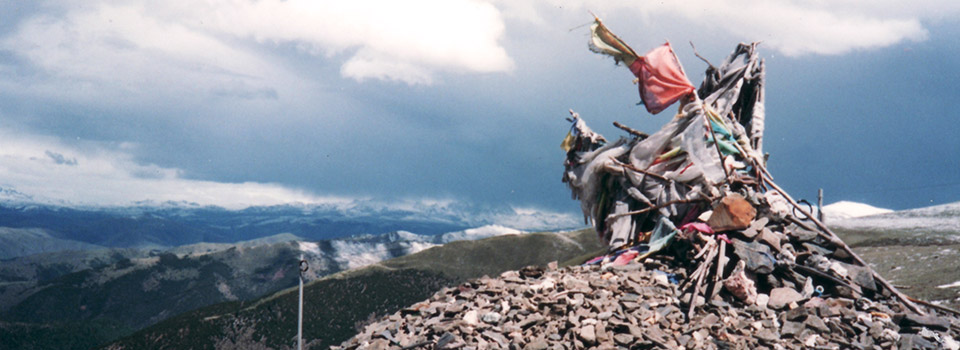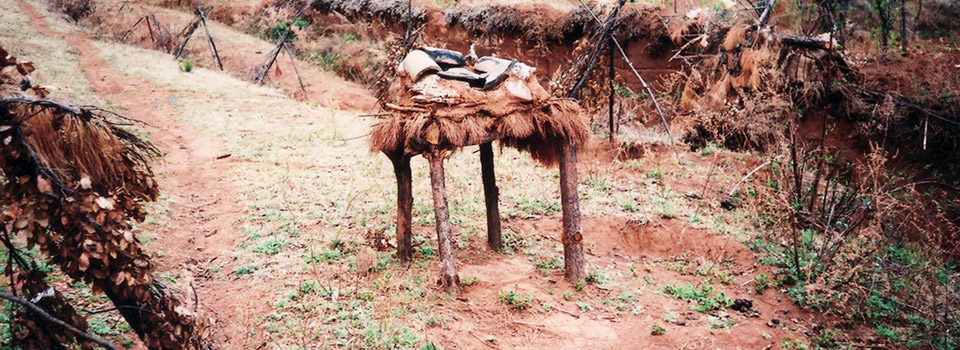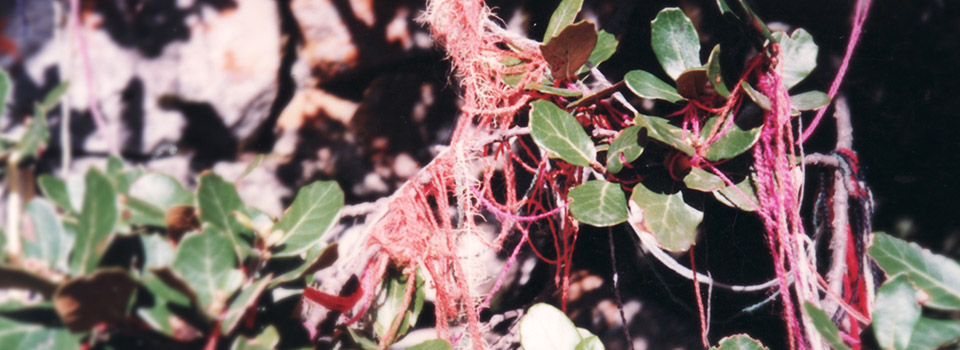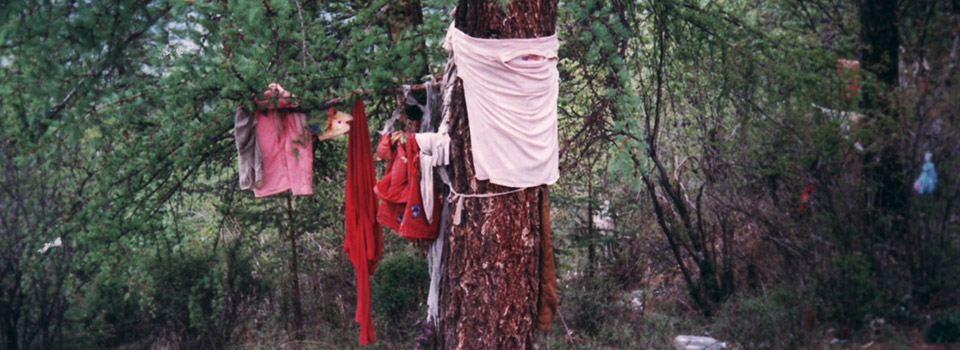காம் பூமியின் மிகவும் தனித்துவமான உயிரியல் பகுதிகளில் ஒன்றாகும். இது கிங்காய்-திபெத்திய பீடபூமி மற்றும் சீன மாகாணங்களான சிச்சுவான் மற்றும் யுன்னான் இடையே அமைந்துள்ளது., 'கலாச்சார திபெத்தின்' மூன்று பகுதிகளின் ஒரு பகுதியை உள்ளடக்கியது. காமில் உள்ள உயிர்-கலாச்சார பன்முகத்தன்மையின் பாதுகாவலர்கள் புனித இயற்கை தளங்களின் மூன்று பாரம்பரியங்களை அங்கீகரிக்கின்றனர், அல்லது சம்பிரதாயப்படி பாதுகாக்கப்பட்ட உறைகள். இருவர் திபெத்திய பௌத்தர்கள் மற்றும் மலைகளை உள்ளடக்கியவர்கள் உடன் பழக மற்றும் பள்ளத்தாக்குகள் sbas yul. மூன்றாவது பாரம்பரியம் பௌத்தத்திற்கு முந்தைய அனிமிஸ்டிக் 'மலை வழிபாட்டு முறைகளால்' பாதுகாக்கப்படுகிறது மறு-rr ஒரு தெய்வீகத்தால் பொதிந்த அல்லது numinised இது உறைகள்yul-lha மனித ஆளுமையுடன். அந்த yul-lha உயிரியல் இயற்பியல் வளங்களைச் சொந்தமாகக் கொண்டுள்ளது மற்றும் அடைப்பு வெளிப்படையான இயற்கைப் பாதுகாப்பால் வகைப்படுத்தப்படுகிறது. அத்தகைய புனிதமான இயற்கை தளங்கள் வெட்டப்படாத காடுகளாக இருக்கலாம், சடங்கு கேர்ன்கள் btsas, பல்வேறு நீர் பிடிப்புகள் ரி ர்க்யா க்ளங் மற்றவர்கள் மத்தியில்.
காமின் ஷாமன்கள் மற்றும் பூசாரிகள் பெரும்பாலும் மரங்களைப் பற்றி அறிந்தவர்கள், தாவரங்கள் மற்றும் விலங்குகள் மற்றும் சுற்றுச்சூழல் கதைசொல்லல் மற்றும் டோபோகாஸ்மிக் மத்தியஸ்தம் ஆகியவற்றில் முக்கிய பங்கு வகிக்கிறது. பூர்வீக வாழ்வைக் கட்டமைக்கும் மத முன்னுதாரணங்கள் ஆன்மீக வாழ்வின் ஆதாரங்களுக்கான மரியாதையை அடிப்படையாகக் கொண்டவை., உணவு, இயற்கை வழங்கும் ஆடை மற்றும் தங்குமிடம். இது படைப்பு மற்றும் இயற்கையில் உள்ள ஆன்மீக சக்திகளுக்கு நன்றி உணர்வைத் தூண்டுகிறது. சடங்கு நாட்காட்டிகள் புலம்பெயர்ந்த பறவைகள் போன்ற இயற்கை நிகழ்வுகளை அடிப்படையாகக் கொண்டவை, சில தாவரங்களின் பூக்கும் அல்லது கிரகங்களின் இயக்கம். சிறுபான்மை தேசிய இனத்தவர்களிடையே இயற்கை வள பராமரிப்புக்கான வலுவான பாரம்பரியம் இருப்பதாகத் தோன்றுகிறது, அது அவர்களின் தனித்துவமான மொழிகளிலும் பொறிக்கப்பட்டுள்ளது..
அனிமிஸ்டிக் மற்றும் ஷாமனிஸ்டிக் புனித இயற்கை தளங்கள் ஆபத்தில் உள்ளன.
திபெத்திய பௌத்தர்களின் புனிதமான இயற்கை இடங்கள் அச்சுறுத்தலுக்கு உள்ளாகியுள்ளன.
அனிமிஸ்டிக் மற்றும் ஷாமனிஸ்டிக் தளங்கள் அழியும் அபாயத்தில் உள்ளன மற்றும் ஹான் சீனர்களால் மரம் வெட்டுதல் மற்றும் மீள்குடியேற்றம் போன்ற வெளிப்புற தாக்கங்களால் திபெத்திய புத்த தளங்கள் பெருகிய முறையில் அச்சுறுத்தப்படுகின்றன.. இந்த நடவடிக்கைகள் காலநிலை மாற்றத்திற்கு வழிவகுத்தன, அரிப்பு மற்றும் பனி பேரழிவுகள் மற்றும் தாவரங்கள் மற்றும் விலங்கினங்களின் பன்முகத்தன்மையில் சரிவு மற்றும் உள்நாட்டு கலாச்சாரங்களின் உயிர்வாழ்வில் தாக்கங்கள். வெற்றிக்கான சவால்கள் அடங்கும்:
- வக்கிரமான பொருளாதாரக் கோட்பாடு பொருள்முதல்வாத மதிப்புகள் மற்றும் மேற்கத்திய அறிவியலின் கலாச்சார உயரடுக்கை மையமாகக் கொண்டது, இதன் விளைவாக குறுகிய திட்டமிடல் மற்றும் கொள்கை,
- கலாச்சார ஒருங்கிணைப்பு மற்றும் ஒரு புதிய அடைப்பு இயக்கத்தால் கட்டாயப்படுத்தப்பட்ட நாடோடிகளின் உட்காருதல் (எ.கா. வரலாற்று மேய்ச்சல் நிலத்திற்கு வேலி அமைத்தல்),
- அதிகார உறவுகளில் உள்ள ஏற்றத்தாழ்வுகளை கவனிக்காத வளர்ச்சி நிகழ்ச்சி நிரலை திணித்தல்,
- என்ற குழப்பம் "ஆன்மவாதம் சார்பான" மற்றும் "திபெத்திய பௌத்தர்" புனித இடம் மற்றும் இடத்தின் அனுபவம்.
காமின் புனிதமான இயற்கை தளங்கள் மற்றும் உயிரியல்-கலாச்சார பன்முகத்தன்மையை உறுதி செய்ய ஏ "கலாச்சார வரைபடம்" வேலைவாய்ப்பால் அதிகரிக்கப்பட்டது "அறிவு தரகர்கள்".
பாதுகாப்பு கருவிகள்
கலாச்சார மேப்பிங் (அல்லது பங்கேற்பு GIS) பரந்த அளவிலான ஆராய்ச்சி நுட்பங்கள் மற்றும் கருவிகளைப் பயன்படுத்தி உயிர்-கலாச்சார பன்முகத்தன்மையை மேம்படுத்துவதை நோக்கமாகக் கொண்டுள்ளது "வரைபடம்" உள்ளூர் நிலப்பரப்புகளுக்குள் தனித்துவமான மக்களின் உறுதியான மற்றும் அருவமான கலாச்சார சொத்துக்கள் மற்றும் அபிலாஷைகள். முத்திரையிடப்பட்ட அல்லது பாதுகாக்கப்பட்ட வரைபடத்திற்கு முன்னுரிமை அளிக்கப்பட வேண்டும் ரி-ர்கியா தொடர்புடைய பிரதேசங்கள் yul-lha.
அறிவு தரகர்கள் உள்ளூர் புவி பராமரிப்பு நடைமுறைகள் மற்றும் நம்பிக்கைகள் மற்றும் அரசு மற்றும் பிற பங்குதாரர்களுக்கு இடையே ஒருங்கிணைப்பை அடைய வேண்டும்.. . அறிவுத் தரகர்கள் பழங்குடியின மக்களின் நலனையும் அவர்களின் உயிர்-கலாச்சார பன்முகத்தன்மையையும் பல உலகக் கண்ணோட்டங்களையும் முன்னுதாரணங்களையும் அவர்களின் பூர்வீக "வாடிக்கையாளர்களின்" பிரச்சனைகள் அல்லது அபிலாஷைகளைச் சுற்றி கொண்டு வருவதன் மூலம் மேம்படுத்துகின்றனர்.. இந்த அணுகுமுறையின் வெற்றி மாநிலத்தின் அரசியல் விருப்பத்தைப் பொறுத்தது.
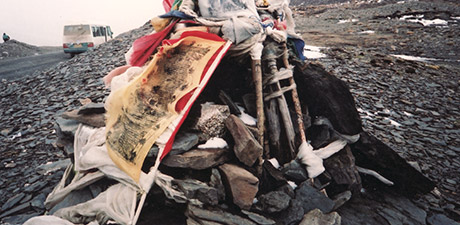 குலுகேவில் உள்ள ஒரு அனிமிஸ்டிக் கெய்ர்ன் லா-பிட்சாஸ் பொதுவாக பிராந்திய ஆவிகள் யுல்-லாவை கௌரவிக்கப் பயன்படுகிறது மற்றும் இது சடங்கு ரீதியாகப் பாதுகாக்கப்பட்ட ரி-ர்க்யாவில் அமைந்துள்ளது.. அது காற்று குதிரைகள் rlung-rta சித்தரிக்கும் பிரார்த்தனை கொடிகள் மூடப்பட்டிருக்கும். காற்று குதிரை என்பது ப்லா அல்லது ஆன்மாவின் உருவகம் மற்றும் நல்வாழ்வின் சின்னமாகும்.
(போட்டோ: ஜே. Studley, 2002)
குலுகேவில் உள்ள ஒரு அனிமிஸ்டிக் கெய்ர்ன் லா-பிட்சாஸ் பொதுவாக பிராந்திய ஆவிகள் யுல்-லாவை கௌரவிக்கப் பயன்படுகிறது மற்றும் இது சடங்கு ரீதியாகப் பாதுகாக்கப்பட்ட ரி-ர்க்யாவில் அமைந்துள்ளது.. அது காற்று குதிரைகள் rlung-rta சித்தரிக்கும் பிரார்த்தனை கொடிகள் மூடப்பட்டிருக்கும். காற்று குதிரை என்பது ப்லா அல்லது ஆன்மாவின் உருவகம் மற்றும் நல்வாழ்வின் சின்னமாகும்.
(போட்டோ: ஜே. Studley, 2002)
கொள்கை மற்றும் சட்டம்
புனித இயற்கை தளங்களின் பாதுகாப்பு திபெத்திய சுற்றுச்சூழல் ஆன்மீக நெறிமுறைகளின் அடிப்படையில் உள்ளது மற்றும் சட்டப்பூர்வமற்றது, மாநில அல்லது சர்வதேச நிலை அல்லது அங்கீகாரம். திபெத்திய புத்த அனுபவ முறைகள் (மற்றும் புனித நிலம்) சில ஏற்றுக்கொள்ளலை அனுபவிக்கவும், மாநிலத்தால், பௌத்தத்தின் கீழ், அனிமிஸ்டிக் முறைகள் (மற்றும் புனித நிலம்) அவமதிக்கப்பட்ட மூடநம்பிக்கை மரபுகளை முன்னிறுத்தி, பின்னர் அழியும் நிலையில் உள்ளன.
வழக்குகளில், புனித தளங்கள் அரிய பறவைகள் உட்பட, சீன ஹேசல் க்ரூஸ் மற்றும் கோல்டன் ஈகிள் ஆகியவை முதல் வகுப்பு மாநில பாதுகாப்பின் கீழ் வருகின்றன, மற்றவை இரண்டாம் வகுப்பு மாநில பாதுகாப்பின் கீழ் வருகின்றன.
கூட்டணி
காமின் இயற்கையான புனிதத் தலங்களைப் பாதுகாக்க தற்போது முறையான கூட்டணி இல்லை, ஆனால் கலாச்சார மேப்பிங்கை வளர்ப்பதில் தனிநபர்கள் மற்றும் நிறுவனங்களின் ஆர்வம் உள்ளது.. கன்சர்வேஷன் இன்டர்நேஷனல் ஒரு தொடங்கியுள்ளது "திபெத்திய புனித நிலங்கள்" திட்டம். அடையாளம் கண்டுள்ளனர் 130 கலாச்சார திபெத்தில் மில்லியன் ஹெக்டேர் மற்றும் 2000 காஞ்சி ப்ரிஃபெக்சரில் உள்ள தலங்கள், இவை அனிமிஸ்டிக் அல்லது திபெத்திய புத்த புனித நிலங்கள்.
பல தனிநபர்கள் மற்றும் நிறுவனங்கள் புனித நிலங்களின் புவியியல் அளவைக் கண்டறிந்து அளவிடுவதற்கும் அவற்றின் உயிரியல்-கலாச்சார நிலைத்தன்மைக்குத் தேவையான உள்நாட்டு அறிவைப் பெறுவதற்கும் ஒரு கலாச்சார வரைபட முன்னோடித் திட்டத்தில் விருப்பம் தெரிவித்துள்ளன.. இந்த திட்டம் ஒரு முன்மாதிரியாக மாறும் மற்றும் காம் மற்றும் திபெத் முழுவதும் நகலெடுக்கப்படும். இன்றுவரை அறிவாற்றல் ஆராய்ச்சி (Studley 2005, 2010) கிழக்கு காம் மக்களிடையே, ஒரு குறிப்பிட்ட பாதுகாப்பு அணுகுமுறைக்கு உத்தரவாதம் அளிக்கும் அளவுக்கு ஒத்ததாக இருக்கும் பூமி பராமரிப்பு மற்றும் வன மதிப்புகளின் பரந்த போக்குகள் மற்றும் வடிவங்களை அடையாளம் கண்டுள்ளது.. இது உள்ளூர் வழிகாட்டுதலால் அதிகரிக்கப்பட வேண்டும் "கலாச்சார வரைபடம்" திட்டம் மற்றும் வரிசைப்படுத்தல் "அறிவு தரகர்கள்".
வனவிலங்குகளை திறம்பட பாதுகாப்பதன் காரணமாக ஃபாக் மோ க்ளிங்கின் மடாலயத்திற்கு ஆதரவாக யாஜியாங் கவுண்டி வனவியல் பணியகம் மற்றும் கன்சர்வேஷன் இன்டர்நேஷனல் ஆகியவை இப்பகுதியில் பல நிறுவனங்கள் மற்றும் தனிநபர்கள் செயல்பட்டு வருகின்றன., காஞ்சி திபெத்திய மாகாணத்தின் சூழலியல் பாதுகாப்புக்கான பரிசு வழங்கப்பட்டது 2005. காமில் பூமி பராமரிப்பு மற்றும் வன மதிப்புகளின் மேப்பிங் ஒரு தளத்தை வழங்கியுள்ளது (மற்றவற்றுடன்):
- உள்ளூர் சமூக மற்றும் கலாச்சார அமைப்புகளை சமரசம் செய்யாமல் குறிப்பிட்ட உள்ளூர் சமூகங்களின் சுற்றுச்சூழல் உணர்வைப் புரிந்து கொள்ளுங்கள், பாலின உறவுகள் அல்லது நல்வாழ்வு,
- ஒரு குறிப்பிட்ட பாதுகாப்பு அணுகுமுறைக்கு உத்தரவாதம் அளிக்கும் அளவுக்கு வன மதிப்புகள் ஒத்ததாக இருக்கும் நன்கு வரையறுக்கப்பட்ட புவியியல் பகுதிகளை அடையாளம் காணவும்,
- புவி பராமரிப்பு மற்றும் வன மதிப்புகளில் ஏற்படும் மாற்றங்கள் அடிப்படை உயிர் இயற்பியல் அல்லது பொருளாதார நிகழ்வுகளில் ஏற்படும் மாற்றங்களை அடையாளம் காணவும் (எ.கா. சந்தை பொருளாதாரம்).
"உள்ளூர் காடுகளையும் விலங்குகளையும் நாங்கள் கவனித்துக்கொண்டால் ஜோ போ [உள்ளூர் பாதுகாவலர் தெய்வத்தின் பெயர்] மகிழ்ச்சியாக இருப்பார், நம்மையும் நம் சமூகத்தையும் ஆசீர்வதிப்பார். இல்லை என்றால், அவர் கோபப்படுவார், எங்கள் பயிர்கள் அழிந்துவிடும், எங்கள் கால்நடைகள் இறந்துவிடும், நாங்கள் பாதிக்கப்படுவோம்".
- ஹோஸ்ஸைச் சேர்ந்த அனாமிஸ்ட் காம்ப் விவசாயி.
"கலாச்சாரப் புரட்சியின் போது (1966 - 1976) வன கோவில்கள் அழிக்கப்பட்டன மற்றும் உள்ளூர் பூசாரிகள் மற்றும் ஷாமன் துன்புறுத்தப்பட்டனர். பின்னர், 1970கள் மற்றும் 1980களில் காடுகள் அரசாங்க ஒதுக்கீட்டில் அழிக்கப்பட்டன, மேலும் காடுகளுக்கான பொறுப்பை நாங்கள் இழந்தோம்"
- லுகுவிலிருந்து ஒரு பூமி பெரியவர்.
"உள்ளூர் காடுகளையும் விலங்குகளையும் நாம் பராமரித்தால், அது ‘புத்தருக்கு மரியாதை செலுத்த’ ஒரு சிறந்த இடத்தை வழங்கும்.".
- ஹொன்சாவைச் சேர்ந்த திபெத்திய புத்த கம்பா பெண்.
- கன்சர்வேஷன் இன்டர்நேஷனல் ஒரு தொடங்கியுள்ளது "திபெத்திய புனித நிலங்கள்" திட்டம்: வருகை இணையத்தளம்.
- ப்ளாண்டோ, ஏ.-எம். & ஸ்டீன்கெல்னர், மின். 1998, திபெத்திய மலை தெய்வங்கள்: அவர்களின் வழிபாட்டு முறைகள் மற்றும் பிரதிநிதித்துவங்கள்: திபெத்திய ஆய்வுகளுக்கான சர்வதேச சங்கத்தின் 7வது கருத்தரங்கு குழுவில் சமர்ப்பிக்கப்பட்ட கட்டுரைகள் - மேய்ச்சல் 1995, ஆஸ்திரிய அகாடமி ஆஃப் சயின்ஸின் பப்ளிஷிங் ஹவுஸ், வீன்.
- ஹூபர், டி. 1999, தூய கிரிஸ்டல் மலையின் வழிபாட்டு முறை: தென்கிழக்கு திபெத்தில் பிரபலமான யாத்திரை மற்றும் தொலைநோக்கு நிலப்பரப்பு, ஆக்ஸ்போர்டு யுனிவர்சிட்டி பிரஸ், ஆக்ஸ்போர்டு.
- ஹூபர், டி. 2004, 'பிராந்திய கட்டுப்பாடு மூலம் "சீல் வைத்தல்" (rgya sdom-pa): திபெத்தில் ஒரு மத-அரசியல் நடைமுறை', மீண்டும், தொகுதி. 33, பக். 127-152.
- பூல், பி. 2003, கலாச்சார மேப்பிங் மற்றும் பழங்குடி மக்கள். யுனெஸ்கோவிற்கான அறிக்கை.
- சேணம், பி. (2002) ‘சுதேசி அறிவை உலகமயமாக்கல்’. ஆம்: சேணம், பி., பிக்கர், ஒரு. மற்றும் பொட்டியர், ஜே. (ஈடிஎஸ்.) வளர்ச்சியில் பங்கேற்பு: உள்நாட்டு அறிவுக்கான அணுகுமுறைகள். ரூட்லெட்ஜ், லண்டன் மற்றும் நியூயார்க்.
- ஜே. Studley 2010, புவி பராமரிப்பின் அருவமான மதிப்புகளை வெளிப்படுத்துதல்: கிழக்கு காம் மக்களின் சுற்றுச்சூழல்-ஆன்மீக களங்கள் மற்றும் புனித மதிப்புகளை வெளிப்படுத்த அறிவாற்றலைப் பயன்படுத்துதல் வெர்சுரன் பி, காட்டு ஆர், மெக்நீலி ஜேஏ மற்றும் ஓவியோ ஜி (ஈடிஎஸ்) "புனிதமான இயற்கை தளங்கள் : இயற்கை மற்றும் கலாச்சாரம் பாதுகாத்து” எர்த் ஸ்கேன், லண்டன் பக் 107-118.
- ஜே ஸ்டட்லி 2010, நிலையான அறிவு அமைப்புகள் மற்றும் வளப் பொறுப்புணர்வு: கிழக்கு காமின் பழங்குடி மக்களுக்கான இன-வனவியல் முன்னுதாரணங்களைத் தேடி, லம்பேர்ட் அகாடமிக் பப்ளிஷிங், சார்ப்ருக்கென், ஜெர்மனி.
- ஜே. Studley 2007 ஒரு வித்தியாசமான டிரம்மரைக் கேட்பது: ஒரு புதிய முன்னுதாரணம் "காடுகளின் காவலர்கள்", IIED, லண்டன்.
- ஜே ஸ்டட்லி 2005 நிலையான அறிவு அமைப்புகள் மற்றும் வளங்களை வழிநடத்துதல்: கிழக்கு காமின் பழங்குடி மக்களுக்கான இன-வனவியல் முன்னுதாரணங்களைத் தேடி, பிஎச்டி ஆய்வறிக்கை, லௌபரோ பல்கலைக்கழகம்.
- ஜே. ஸ்டட்லி மற்றும் பலர் 2005 சமூகத் தோட்டங்கள் மற்றும் இயற்கைப் பாதுகாப்பிற்கான வன மதிப்புகள் மற்றும் "கலாச்சார இழப்பு" காடு, மரங்கள் மற்றும் வாழ்வாதாரங்கள், 16 (4) பக் 329-358.
- ஜே. ஸ்டட்லி 2002 பி, உள்ளூர் உணர்வின் மூலம் தீர்மானிக்கப்படும் இயற்கை பாதுகாப்பு, சீனாவின் ஹெங்டுவான் மலைப் பகுதியில் அடையாளம் மற்றும் அறிவு, TNC, ஆர்லிங்டன்.
- பல்லுயிர் மற்றும் உள்நாட்டு அறிவு மையம். வருகை இணையத்தளம்.
- மவுண்ட். Kawagebo மற்றும் அதன் யாத்ரீக வட்டம், திபெத் தன்னாட்சிப் பிரதேசம், சீனா. வருகை இணையத்தளம்.
- யாங் ஃபுகுவான் மற்றும் டோங்பா ஆராய்ச்சி நிறுவனம்.
- காம் புனித நிலங்கள் திட்டம்: காமின் சம்பிரதாயப்படி பாதுகாக்கப்பட்ட நிலங்களின் உயிரியல் கலாச்சார பன்முகத்தன்மையை நிவர்த்தி செய்தல். நீங்கள் மேலும் அறிய விரும்பினால் அல்லது பங்கேற்க ஆர்வமாக இருந்தால் தொடர்பு கொள்ளவும்: khamslp@gmail.com


